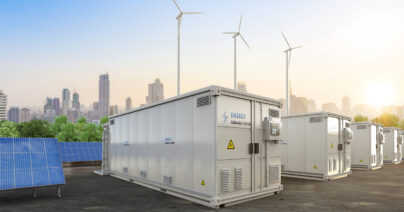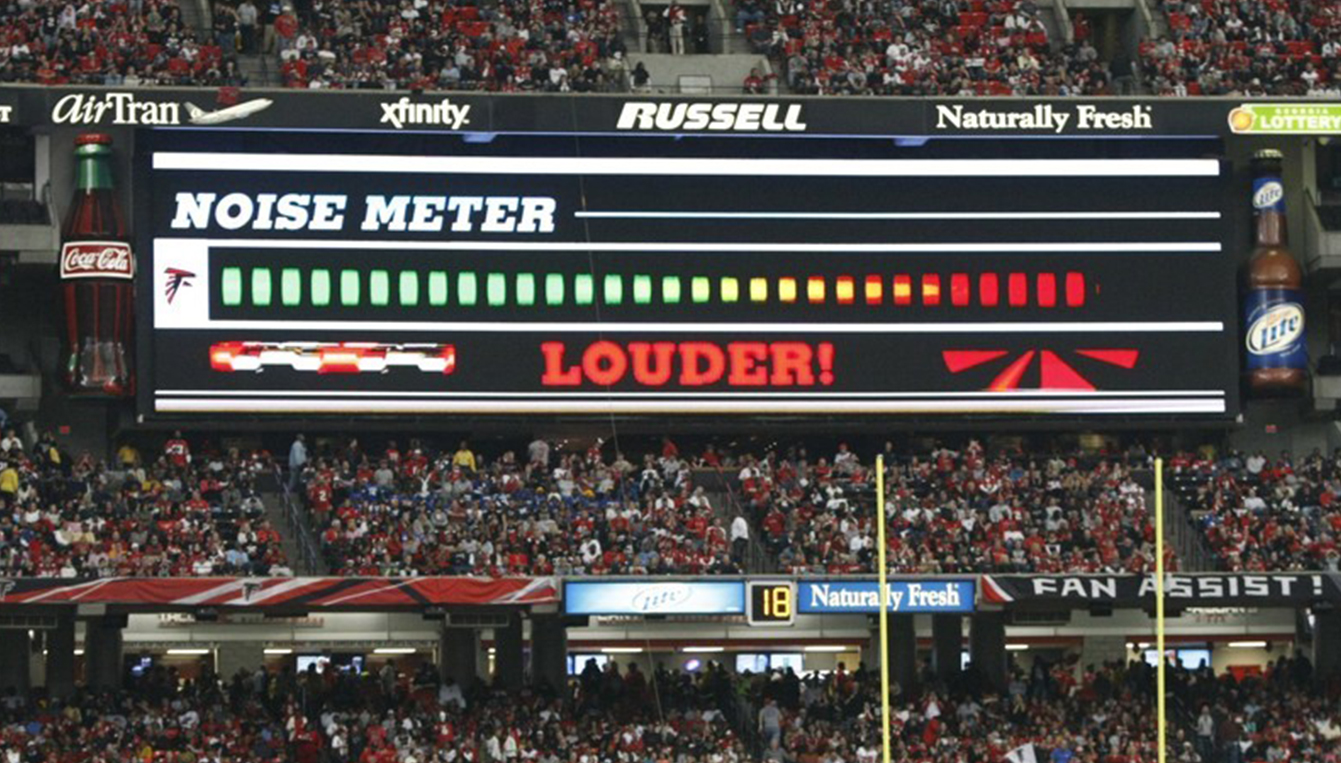 Articles
Articles
Battery Energy Storage Systems (BESS): Charged Up for Noise Control
Methods for storing energy have been employed for decades in the form of pumped hydroelectric reservoirs, compressed air, or via thermal energy transfer. Today we can…

For the second year in a row, the NFL Super Bowl splits the Acentech offices. As we all know, the next championship will pit the New England Patriots (our Cambridge office) vs. the LA Rams (our LA office). This time last year, the Philadelphia Eagles (our Philly office) beat the New England Patriots. For all fans, regardless of what team we’re rooting for, when we get a chance to be in the stadium our part is to scream as loud as possible. Many franchises even make it a key part of the stadium experience. What visiting teams haven’t felt the pressure from the “Twelfth Man” in Seattle’s CentryLink Field, or the flashing jumbotron messages in countless venues asking fans to “Make Some Noise” across the country?
We recently noticed there was some press about Kansas City Chiefs’ record for having the loudest stadium. According to the Guinness Book of World records, “the loudest crowd roar” at a sports stadium is 142.2 dBA, achieved by fans at Arrowhead Stadium back in September 2014.
Wow, 142 dBA, that is loud! For those of us in the sound-measuring business, that is very loud…almost unbelievably loud. As acoustics consultants, we would not be doing our job if we failed to investigate these outrageous claims further. Let’s start by asking some employees at Acentech what’s the loudest thing they’ve ever heard.
Acentech Technical Assistant and Sound Technician, Nick Dragoni is used to loud places. “We measured one night club at only 108 dBA in the center of the dance floor and at one point we measured 124 dBZ (unweighted decibels) in the 31.5 hertz octave band. I don’t suffer from panic attacks, but this experience was probably the closest thing to it and my first reaction was to stop the test because surely they would not play it this loud, but the DJ assured me this is equivalent to a Friday night at the club.”
Principal Consultant, Doug Sturz recalls the sound from the Federal Reserve money-shredding machine at 112 dBA within 6 feet of the shredder. “That was profoundly loud.”
Principal Consultant Michael Bahtiarian remembers the first time he was in a tugboat engine room with two 2500 hp EMD diesel engines operating a full power. “If I recall, the sound level was 128 dBA and I could not hear myself scream at the top of my lungs.”
Principal Consultant Jim Barnes also has some strong memories from his 40-year career consulting on industrial noise issues: “I have observed and measured sound levels near combustion turbines, coal car shakers, high pressure steam releases, and 1000 HP fans….all I believe to be substantially louder than what I’ve experienced at a football game or even a college hockey rink during double overtime.”
When President Jeff Zapfe saw Kiss for the first time in 1974 in London Ontario, Canada, his ears didn’t let him forget. “At the time I was a teenager and didn’t even know what a sound level meter was, but my ears rang for three days. Easily the loudest thing I have ever been a party to.”
Acentech’s Chief Engineering Scientist, Eric Ungar, notes back at BBN (Bolt Beranek & Newman) he and others helped design the Sonic Fatigue Test Facility for Wright-Patterson Air Force Base in Dayton, OH. Eric notes, “I have no records and can’t estimate the sound level, but I can tell you no one was allowed in the building during testing. It surely would have fried their hearing, permanently.”
Yes, we realize that those stadiums are loud, but those “record” sound levels must be off the mark. Consider the sound level of the giant paper shredder at 112 dBA or the sound level in the ship’s engine room at 128 dBA. These levels are 14 to 30 dB quieter than the Arrowhead Stadium record. A difference of 10 dB is perceived as half the sound level. Do we all really think the center of an NFL stadium is that loud?
Our staff did some checking on the stadium measurements. We used Kansas City’s 2013 record-breaking crowd swell of 137.5 dB as an example because it is well documented by the Kansas City Chiefs, the Guinness Book of World Records, and the manufacturer of the sound level meter (SLM) that captured the “record-breaking” noise. One cannot fully understand what a decibel reading means unless you know the context it was measured in, including things like:
• Measurement location
• Time response
• Sound metrics
• Weightings
• Atmospheric condition
Our largest concern is that none of the published articles or press releases surrounding these stadium noise records indicated where the sound was measured from. We all know that sound falls off with distance. Everyone has experienced leaning over a table at a crowded restaurant to better hear someone by getting closer to the sound source. To quantify this with an easy rule of thumb, if you move twice as far away from a sound source, your sound pressure will drop by 6 dB.
So for these stadium noise records do they stick a sound level meter in the mouth of the loudest fan? We assume not, and our staff found a photo showing a SLM meter located at the edge of the seating. So, right here we can state that the record sound level is not what the players would experience, as they would be about 200 feet from the measurement location.
If we look closer at the 137.5 dB reading, as documented from a screen shot published by the record holders, we can see that the data is labelled as “LApeak(max).” What does this mean, and why is it 15 dB higher than the “LAFmax” on the same screen that reads of 122.1 dB? Let’s break it down piece by piece:
“LA” means the measurement is a sound pressure level with A-weighting applied to the results. A-weighting is a way to value frequencies based on how well the human ear perceives them. Essentially, it’s a way to represent the decibel in a manner that the average person will hear. The main takeaway is that humans are bad at hearing low frequencies, and so low frequency content is devalued by this weighting. We believe this to be the proper setting for the stadium measurement.
Next comes the time response. We have the “peak” reading in the 137.5 dB case, and the “F,” or fast, reading in the 122.1 dB case. Fast time weightings correspond to a measurement time of 125 millisecond, and the decibel levels are averaged across the time period. Fast is a very common time weighting used for environmental noise monitoring and would be a proper setting for the stadium measurement. But that is not the case!
Peak measurements have no time weighting to them, rather they show the maximum sound pressure level reached by a single sample during the measurement. Typically a single sample on the a SLM lasts 20 milliseconds, but we learned that the SLM in question can go as low at 2.5 milliseconds. This sampling is not typically used for environmental noise monitoring as a gust of wind can very easily give high peak readings. Peak measurements are typically useful for quick, impulsive sound events like an explosion or a gunshot. Lastly, the “max” just means take the maximum value given the parameters outlined above for the measurement period in question. We agree with using the maximum sample, but not to using the Peak setting.
So when it comes to measuring the loudest roar of a crowd, you may think getting the exact highest peak might be your answer. It certainly helps inflate the numbers so the readings are more exciting, but does it accurately represent the stadium noise? It will depend on who you ask. The Guinness Book of World Records has deemed the LApeak(max) the standard by which stadium noise is to be measured. Regardless of how you measure the sound of your stadium, we can all agree on one thing: when you team is on defense, let’s make some noise!
____
A special thank you to our Principal Consultant Mike Bahtiarian for helping to put this together.